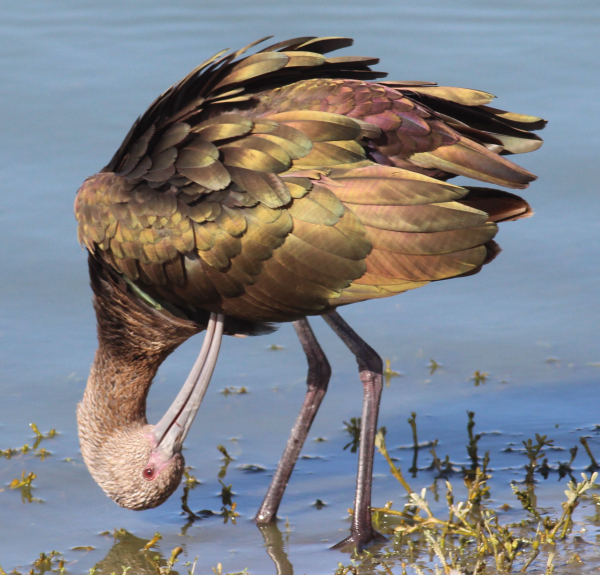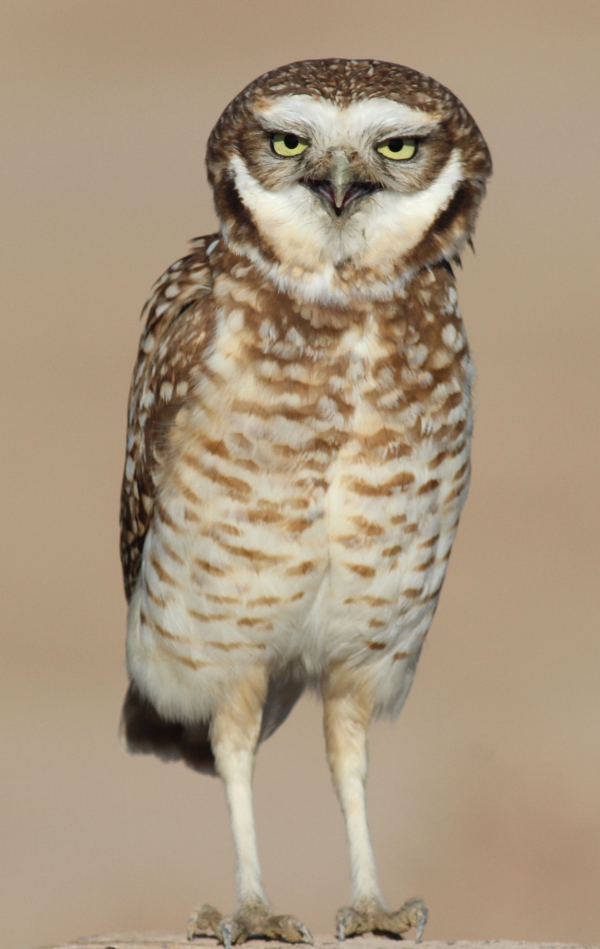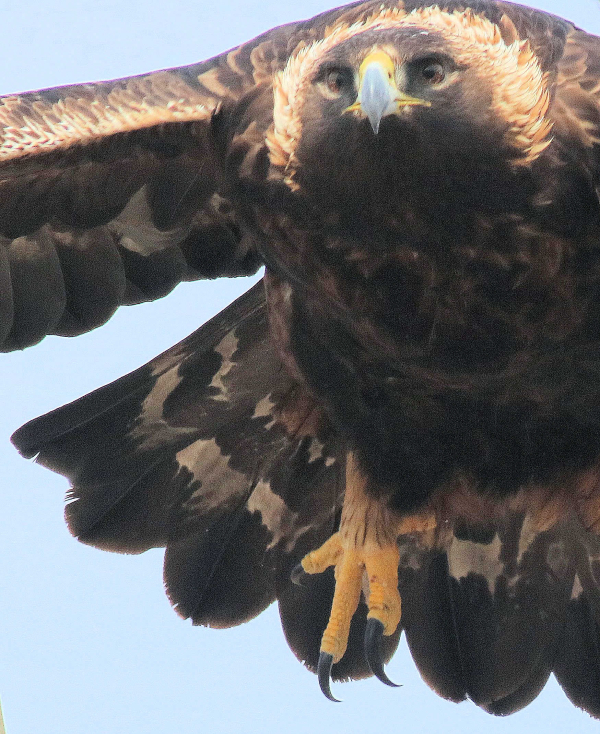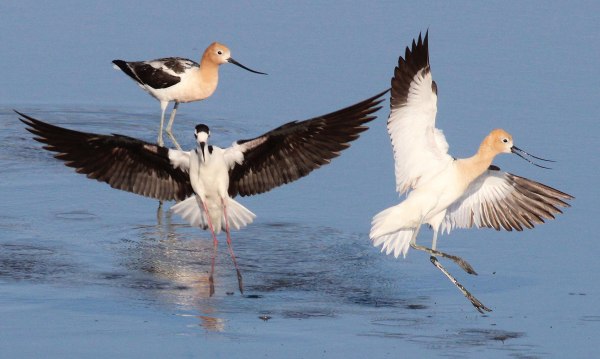Photographing birds is great fun, and it’s personally rewarding; we all like to share our photos with others in one way or another. Eventually, after you get a few good photos in your collection, you may become interested in entering a photo or two in bird photography competitions, and we are often encouraged to do just that by friends, family, and peers who tend to help spur us into action. Even now, there are three bird photography contests available to enter, with one being quite prestigious and offering some pretty attractive prizes – the 2020 Audubon Photography Awards.

Iridescent multi-colored feathers catch your attention until you realize this White-faced Ibis has its neck, head, and long bill inverted below its body as it preens. The photo is sharp, colorful, shows action, has a pleasing setting, looks unusual if not a little comical – but does it have what it takes to win over contest judges and compete with a field of exceptional photos?
Open to amateurs and professional photographers, the Audubon photo contest has six categories, and you can win some serious prizes – up to $5,000 cash, along with international accolades! You can submit your photos until noon April 6, so there’s even time to take an award-winning photo if you don’t already have one in your files. You can get all the contest information at https://www.audubon.org/get-outside/audubon-photography-awards-official-rules

An unusual clown-like pose by a displaying Burrowing Owl is sharp and technically correct with perfect light and a pleasing background, but this photo would be even better if submitted with others in the series of images taken as it transformed from an inactive perched bird into a bowing, turning, calling, stretching actor of innate behaviors.
|
Another on-going photo contest is associated with Project FeederWatch – the BirdSpotter Photo Contest, which has a couple more weeks to go, including two different categories of competition running from February 3 to 13, and from February 17 to 27. Learn more and review the photos already submitted to earlier category contests, including category winners, at https://feederwatch.org/birdspotter2019-20/
The Great Backyard Bird Count (GBBC) also has a photo contest, which only lasts for the duration of the GBBC event – from February 14 through 17. In spite of its name, photos for the GBBC photo contest don’t need to be taken in your yard – they can be taken anywhere, of any wild birds. For all the rules and to see photos submitted during the contest period, see https://gbbc.birdcount.org/photo-contest-rules/
Two of these bird photo contests – the BirdSpotter and GBBC contests – are becoming more about sharing with other birders than necessarily winning the contest, and that’s great too. Photos submitted by participants are shared in online galleries where anyone can review photos among the wealth of other photos being submitted. You can even get involved in voting for your favorite images! You can also see how you measure up with the rest of the crowd, and have fun in the process by checking out the competition. And you can get a measure for the quality of hobbyist bird photographers overall: The good news is that bird photography is growing more popular annually, and the quality of photos is improving too.
Photo Qualities
If you want to get more serious about your chances of winning a bird photography contest, there are a few principles to consider in a given photo to assess its potential to win. As you review your bird photos for a contest winner, there are a few things you can keep in mind that will help your chances of winning, and improve the photographs you take in the field that might be improved by keeping these elements in mind. I do have a number of years of experience as a wild bird photo contest judge, in addition to being a very active wildlife photographer, so I dare to suggest I might be able to provide some helpful advice.

Your attention is immediately directed to the intense eyes, face, and talons of this grand Golden Eagle in attack mode. Unusual framing may help it compete for judges’ attention, or it may detract from their interest. Nonetheless, it is a bold image of nature unleashing a potent predator of the sky – feared by furred and feathered beasts alike.
|
The following list of photo qualities may be helpful when you consider what images to select to enter bird photo contests:
- Photo Sharpness and technical quality.
- Color and Lighting – the natural colors produced with the lighting needed to bring out those colors, while being aware of the effects of shadows and shade on the image.
- Action, or perceived action, of birds almost always beats a “bird on a stick,” and action photos of birds attract a lot of attention from viewers and contest judges.
- Unique Qualities – other elements in the photo such as a flower or branch, rock or sky or water, food or prey; an interaction or reaction; a moment suspended in a photo.
- Composition – the framing or positioning of the subject and other elements in a photo (avoid photos with distracting backgrounds or surroundings).
- Unusual – anything unique or beyond the norm can attract the attention of contest judges too.
- The Overall Image a given photo conveys can be as important as the bird or birds in the photograph.
The above considerations are very important to any photo, in addition to photos submitted to any bird photo contest. But it’s worth noting that photo contest judges can be fickle. In one of last year’s contests, the grand prize winning photo was of a Red-winged Blackbird taken in poor lighting conditions, which makes you wonder if the majority of the judges are birders, or bird photographers – some are, some aren’t. In the case of the BirdSpotter Photo Contests, fellow birders can vote for their favorite photos, which is a great way to be honored by your peers, and win some quality prizes.
In short, select “the best of your best” bird photographs for contests, and use the above considerations while photographing in the field – whenever you can – to make sure each photo you take has some of the qualities that will help you win a bird photo contest. For most of us, that’s what matters most: That we get the best photograph out of each photo opportunity, with the potential of taking a photo contest contender on your next outing. Keep trying, keep photographing, keep improving.

Moments after a tranquil scene illuminated by bright light erupted into an explosion of activity, calm water provided an arena for a territorial clash between a pair of American Avocets and a neighboring Black-necked Stilt. With the action stopped in a fraction of a second, you can almost hear the avocet’s angry cry. Judges? What’s your call?
Oh yes, there’s one more element – Luck. Luck in getting a contest-quality photo, and luck in getting the contest judges to agree that your photo has all the right stuff to make it a winner – Good Luck!
Article and photos by Paul Konrad